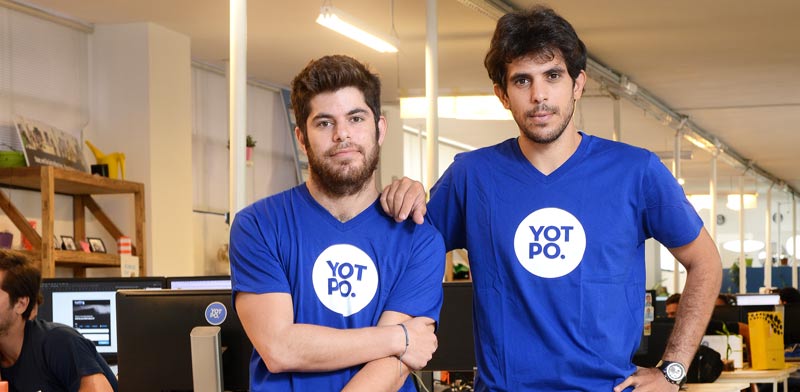How Yotpo’s “Think Small to Scale Big” Strategy Wins in an eCommerce-First World
Founded in 2011 by Omri Cohen and Tomer Tagrin as a platform for creating consumer reviews and visual content, Yotpo soon showed its potential in the field of e-commerce. In just ten years, it has expanded to over 450 workers, 30,000 clients, and 500 partners and partnerships throughout the world. It just recently secured $200 million in investment and are now worth more than $1.4 billion.
To get those impressive numbers, Yotpo has experienced a long strategic journey. Let’s discover the stories that put this E-commerce marketing startup on new height!
One Negative Review Started It All
“The idea for innovation usually comes from minor troubles in life” – this statement is true in the case of Yotpo. Cohen and Targin met at Tel Aviv University before they co-founded Yotpo. The reason they founded Yotpo was because one of Targin’s friends made fun of them that they did not buy him anything for his birthday. Being the geek, they did the research online to find a fancy camera for that friend. However, as their decision was based on a fake review, their present was not as good as they expected.
“That’s when we decided, “Okay, let us solve authenticity with reviews, and let’s create trust on that.”” – That was their initial idea for a startup business.
During that time, they began interviewing a large number of Amazon’s top reviewers. They interviewed a lot of businesses, but they didn’t know how to get to merchants. Being two engineers based out of Israel without any foundation of marketing, business development or sales, they determined the best Application Programming Interface (APIs) would be their choice. Shopify satisfied them.
After that, they just built Shopify integrations to build scrapers and had an algorithm for ranking the reviews. Soon realizing the number one problem was to verify whether the reviewer actually bought the product or not, they connected to the business side and closed the loop by generating the reviews themselves.
Then, they officially launched Yotpo on Shopify’s App Store – and that is how their got their first customers thanks to Shopify’s APIs. More specific, after one business’s customers buys something, it would send them an email asking them to write a review and redirect them to Yotpo.
“Then we built another technology called “email review” where you don’t need to leave the email in order to give a review, you just reply. Then the entire notion of post-purchase email came up — that was our epiphany. So, we did that.” – said Targin in the interview with Shopify.

At a century that “everyone is selling everything online,” Yotpo eCommerce package soon got the attention from not only companies but also investors.
Raising Capital & Going Enterprise: Not the Same!
Integrating with a variety of business tools, such as Google, Instagram, other eCommerce platforms, the Yotpo currently lands a massive round and over billions dollar valuation. However, few people know the difficulties of raising capital in the commerce realm that its founders had to face in the initial stage.
Before Yotpo became a phenomenon, it got a lot of skepticism from the investors. They asked two founders to sell the software to Best Buy or Macy’s, to go enterprise like GSI Commerce or Magento or even to focus on other market instead of Server Message Block (SMB) in E-commerce. However, Yotpo knew that it wanted to see these small businesses thrive. There was so much opportunity to serve those customers and create a super successful business if it successfully did it in Shopify.
“It was definitely a nightmare experience. On the one hand, it was because we didn’t understand a lot of what was going to happen during that process. But on the other hand, we knew that we wanted to build software for SMBs.” – said Targin. No one wants clumsy, difficult-to-use, difficult-to-update solutions that requires business to modify its entire system with a single modification. That’s why Yotpo decided to supply simplified turnkey software solutions instead of go enterprise, regardless of the pressure from investors.
Capture The Distinctive
In order to turn into professional business, the founders needed to craft a vision for the future of the company first. And the vision, sometimes, was just to identify what distinguish the product. According to Targin CEO, eCommerce is all about gaining consumers’ attention and delivering a cohesive, engaging response. However, some business’s biggest challenge was that they had so many different marketing tools, vendors, and programs, and none of them were talking to each other.
Although the business-building benefits of that level of customer experience and service are pretty evident, Tagrin pointed out that eliminating the negatives is also valuable, noting the awkwardness that arises when the customer review silo doesn’t communicate with the loyalty or marketing silos.
“When you think about eCommerce brands, all day long they’re trying to stitch together point solutions, with referrals and SMS and reviews and loyalty and engagement tools, and just so many different things,” Tagrin said. “What’s unique about Yotpo is we’re connecting that all together.”

Cue a Complete Rebuild and the Achievement!
The ever-changing landscape of eCommerce is both scary and exciting. Every year, there are changes that may help us grow our businesses or new challenges that we may not be able to keep up. Whatever difficulties you may have encountered this year; the eCommerce market is still expanding bigger and brighter as ever. Against this backdrop, Yotpo has seen exponential growth alongside its partner ecosystem after an incredible renovation.
It was five years ago, in 2016 that Yotpo raised a bunch of money. It was doing like $8 million ARR, growing 137 percent at that point. On the one hand, 100 percent probability, without a doubt, Yotpo will get to $50 million ARR. Maybe it will take more than a year, but in a year more or less, it can get to that. On the other hand, the founder realized that that maybe it would never reach $100 million ARR. Why?
The answer was simple. Back in that day, Yotpo were just a reviews company which had to face 2 big problems. First, the founders found that the Total Addressable Market (TAM) of the company is not big enough. And second, as the article mentioned below, because it occupied the lower end of the market – small businesses, it had to take notice on competitors that were building, let’s say, 50 percent of the products for 20 percent of the price.
The founders realized that creating a long-term moat and truly building a large firm would be extremely difficult. After spending a long time talking to experts and customers, they realized the greater issue was that there was a difficulty in the middle of the categories.
Every brand is attempting to get consumer attention by creating a positive consumer experience. They can’t because they need to link their loyalty program to reviews, their visual marketing suite to loyalty systems, and referrals to SMS.

“Let’s consolidate everything. Let’s become what we call an ecommerce marketing platform to really help brands. Make it easier for them to focus on building great experiences.” They started thinking about all of the solutions under the same data platform.
They completely invest in and rebuild the platform. For the last five years, Yotpo made a huge change in its architecture. It built more products, acquired more company, and optimized its platform. Today, Yotpo’s services today include SMS and visual marketing, loyalty and referral services and reviews and ratings included in four main products — Yotpo SMS Marketing, Yotpo Loyalty & Referrals, Yotpo Reviews and Yotpo Visual UGC which are used by a range of e-commerce companies, spanning from newer direct-to-consumer brands like Third Love and Away, to more established names like Patagonia and 1-800-Flowers. Some of these have been built in-house, and some by way of acquisition — most recently, SMSBump, in January.
How did it succeed?
From a consumer standpoint, it’s easy to understand Yotpo’s success: it can help brands accelerate their growth by enabling advocacy and maximizing customer lifetime value. However, to its operation runner point of view, the recipe for success is more fabulous.
#1. Chance-Grabbing
From the moment its 2 co-founders Cohen and Targin built the app based on their fledgling idea to fundraising stage and its renovation, Yotpo is a chain of chance-grabbing.
“We just had the right timing. It’s not that we were great on marketing, or we did Shopify App Store optimization. We just put the app out. It was great timing. We built. We were engineers.” – Kept telling Targin.
#2. Vibrant Ecosystem
Not only did Yotpo get Shopify builds, buys, partners, invests, acquires but they also operated activity happening outside of this platform. The ecosystem continues to grow in all these separate ways so that people have multiple options to create successful business for themselves, whatever that looks like.
#3. Strong Team
“We would have never gotten here without the people that make up Yotpo. And there are certain people in Yotpo that have been with us for 10, eight, and five years, and it’s absolutely amazing to see there. Winning is a team sport—don’t forget about the team.”- said Tagrin.
To Yotpo’s CEO viewpoint, that its resolute staff as well as unite culture contribute to the company’s success.
The Company’s Picture During COVID-19
The COVID-19 pandemic has had a significant impact on internet use, particularly e-commerce, since people flocked to digital channels in record numbers to purchase goods while adhering to shelter-in-place orders or attempting to increase social distance in order to slow the spread of the coronavirus.
As a result, in spite of the fact that e-commerce has been on the increase for years, this trend has accelerated dramatically since February – with income and spend both routinely exceeding baseline levels over the previous several months – according to statistics from digital marketing agency Common Thread Collective,
Like the domino effect, firms that assist such e-commerce enterprises in operating in more direct and personal methods have seen a significant increase in business. Yotpo is not the exception. It even is a direct beneficiary: the company reported a rise in new customer sign-ups, with many of them opting for premium services, resulting in a 170 percent year-over-year ARR and decreased customer turnover.
Of course, it is not the positive side at all while thousands of layoffs throughout the IT industry and a large number of brick-and-mortar store closures. Those economic indications might have a knock-on impact, causing not just more companies to go online, but also a reduction in general expenditure somehow.
That will obviously have an influence for companies like Yotpo, which does not have strong cash flow. Maybe now it on the rise but for far vision in considering the economy’s impact, it may expand its offerings to satisfy a broader range of client use cases in long run.

This is a big part of our product in our meetings and debates,” Tagrin said about product expansions. “I do think any celebration of growth and funding comes to me with something else: we need to be internalizing more what is going on,” he said. “The world is not back to normal, and we shouldn’t act like it is.”
For example, currently, the company addresses customer care needs by way of integrations with companies like Zendesk, but longer term it might consider how it can bring in services like this to continue to build out the touchpoints between D2C brands and their customers, and specifically running those through a bigger picture of the customer as profiled on Yotpo’s platform.
Although the company has fresh funding in hand, Tagrin is anything but complacent, and said Yotpo was fortunate to have been in the eCommerce business during the otherwise disastrous COVID era. That said, he plans to keep on grinding with the challenging work involved in creating products that reflect the power of using deeply integrated marketing tools.
“We are literally just getting started,” said Tagrin. “We think that in order for us to fulfill our platform vision, we have at least 10 years of work ahead of us.”
The Bottom Lines
With its technology-backed approach and innovated thinking, Yotpo has been ahead of the curve in so many ways. The company is promising to be a formidable competitor for any similar platform in this field.









